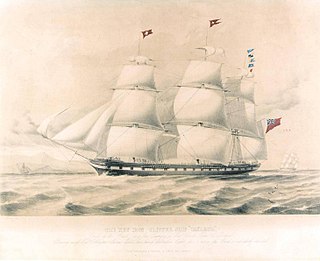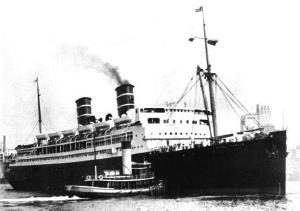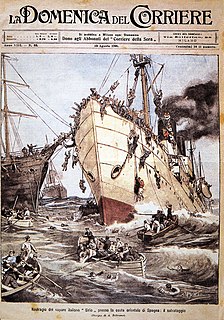
The PS Lady Elgin was a wooden-hulled sidewheel steamship that sank in Lake Michigan off the fledgling town of Port Clinton, Illinois, whose geography is now divided between Highland Park and Highwood, Illinois, after she was rammed in a gale by the schooner Augusta in the early hours of September 8, 1860. The passenger manifest was lost with the collision, but the sinking of Lady Elgin resulted in the loss of about 300 lives in what was called "one of the greatest marine horrors on record". Four years after the disaster, a new rule required sailing vessels to carry running lights. The Lady Elgin disaster remains the greatest loss of life on open water in the history of the Great Lakes.

SS Andrea Doriapronounced [anˈdrɛːa ˈdɔːrja], was an ocean liner for the Italian Line home-ported in Genoa, Italy, known for its sinking in 1956, where of the 1,706 passengers and crew, 1,660 were rescued, while 46 lost their lives.

RMS Tayleur was a full-rigged iron clipper ship chartered by the White Star Line. She was large, fast and technically advanced. She ran aground off Lambay Island and sank on her maiden voyage in 1854. Of more than 650 aboard, only 280 survived. She has been described as "the first Titanic".

SS Atlantic was a transatlantic ocean liner of the White Star Line that operated between Liverpool, United Kingdom, and New York City, United States. During the ship's 19th voyage, on 1 April 1873, she struck rocks and sank off the coast of Nova Scotia, Canada, killing at least 535 people. It remained the deadliest civilian maritime disaster in the North Atlantic Ocean until the sinking of SS La Bourgogne on 2 July 1898 and the greatest disaster for the White Star Line prior to the loss of Titanic in April 1912.

Cataraqui was a British barque which sank off the south-west coast of King Island in Bass Strait on 4 August 1845. The sinking was Australia's worst ever maritime civil disaster incident, claiming the lives of 400 people.

SS Morro Castle was an American ocean liner that caught fire and ran aground on the morning of September 8, 1934, en route from Havana, Cuba, to New York, United States, with the loss of 137 passengers and crew.

Marco Polo was a three-masted wooden clipper ship, launched in 1851 at Saint John, New Brunswick. She was named after Venetian traveler Marco Polo. The ship carried emigrants and passengers to Australia and was the first vessel to make the round trip from Liverpool in under six months. Later in her career, the ship was used as a cargo ship before running aground off Cavendish, Prince Edward Island, in 1883.

The Pacific Mail Steamship Company was founded April 18, 1848, as a joint stock company under the laws of the State of New York by a group of New York City merchants. Incorporators included William H. Aspinwall, Edwin Bartlett, Henry Chauncey, Mr. Alsop, G.G. Howland and S.S. Howland.

Sir Charles Hardy Islands is in the reef of the same name adjacent to Pollard Channel & Blackwood Channel about 40 km east of Cape Grenville off Cape York Peninsula.

MV Astoria is a ship that was constructed as the transatlantic liner MS Stockholm for Swedish American Line, and rebuilt as a cruise ship in 1993. Ordered in 1944, and commenced service in 1948, at 73 years old, she was the oldest passenger liner still sailing in deep water routes. As Stockholm, she was best known for an accidental collision with Andrea Doria in July 1956, resulting in the sinking of the latter ship and 46 fatalities off the coast of Nantucket.

The SS Mohegan was a steamer which sank off the coast of the Lizard Peninsula, Cornwall, on her second voyage. She hit The Manacles on 14 October 1898 with the loss of 106 out of 197 on board.

HMS Porpoise was a 12-gun sloop-of-war originally built in Bilbao, Spain, as the packet ship Infanta Amelia. On 6 August 1799 HMS Argo captured her off the coast of Portugal. Porpoise wrecked in 1803 on the North coast of what was then part of the Colony of New South Wales, now called Wreck Reefs, off the coast of Queensland, Australia.

SS Utopia was a transatlantic passenger steamship built in 1874 by Robert Duncan & Co of Glasgow. From 1874 to 1882 she operated on Anchor Line routes from Glasgow to New York City, from Glasgow to Bombay and from London to New York City. After 1882 she carried Italian immigrants to the United States.

SS Sirio was an Italian merchant steamer that had a shipwreck off the eastern Spanish coast on August 4, 1906, causing the deaths of at least 150 Italian and Spanish emigrants bound for Brazil, Uruguay, and Argentina. The shipwreck gained notoriety because the captain, Giuseppe Piccone, abandoned ship at the first opportunity. The wreck had a profound effect on communities in northern Italy and was remembered in popular songs of the era.

The SS Schomberg was a clipper built in Aberdeen by Alexander Hall & Co. for "the Black Ball line" for carrying large cargoes and steerage passengers, and to "outdo the Americans". When built, she was regarded as the most luxurious and well-built clipper of the period.

Charles Eaton was a barque, launched in 1833 for use as a merchant ship. Whilst under the command of Captain Fowle, she was wrecked in 1834 among the Torres Strait Islands, off the northern coast of Queensland, Australia, and her passengers and crew attacked and nearly all killed by Torres Strait Islanders on Mer Island. A cabin boy and small child survived and lived with the islanders until being rescued by Captain Lewis and crew on Isabella in June 1836, who also found skulls of some of the murdered people on a nearby island and took them back to Sydney for burial.
Driver was a clipper ship, constructed for David Ogden et al in 1854 at Newburyport, Massachusetts. She sailed between New York and Liverpool carrying immigrants to the US for the Red Cross Line. She was lost at sea with no known survivors after setting sail from Liverpool 12 February 1856. 377 lost their lives.
The Exmouth was a brig built in 1818. She was classed as a snow in Lloyd's Register of 1845. She worked as a whaler prior to her life as an emigrant ship sailing between Londonderry and Quebec. She was wrecked against the south side of the Isle of Islay in 1847 during a storm. Two hundred and forty-one people lost their lives; three crewmen survived.


















